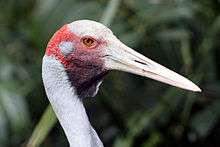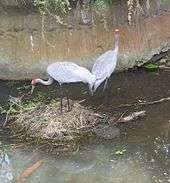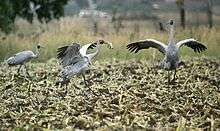Brolga
| Brolga | |
|---|---|
 | |
| Brolga (Antigone rubicunda) | |
| Scientific classification | |
| Kingdom: | Animalia |
| Phylum: | Chordata |
| Class: | Aves |
| Order: | Gruiformes |
| Family: | Gruidae |
| Genus: | Antigone |
| Species: | A. rubicunda |
| Binomial name | |
| Antigone rubicunda (Perry, 1810) | |
| Synonyms<"AFD"/> | |
| |
The brolga (Antigone rubicunda), formerly known as the native companion, is a bird in the crane family. It has also been given the name Australian crane, a term coined in 1865 by well-known ornithological artist John Gould in his Birds of Australia.
The brolga is a common, gregarious wetland bird species of tropical and south-eastern Australia and New Guinea. It is a tall, upright bird with a small head, long beak, slender neck and long legs. The plumage is mainly grey, with black wing tips, and it has an orange-red band of colour on its head. It is well known for its intricate mating dance. The nest is built of sticks on an island in marshland and usually two eggs are laid. Incubation takes 32 days and the newly hatched young are precocial. The adult diet is mostly plant matter, but invertebrates and small vertebrates are also eaten.
Although the bird is not considered endangered over the majority of its range, populations are showing some decline, especially in southern Australia, and local action plans are being undertaken in some areas. It is the official bird emblem of the state of Queensland.
Taxonomy

When first described by the naturalist George Perry in 1810, the brolga was misclassified as a species of Ardea,[2] the genus that includes the herons and egrets. It is in fact a member of the Gruiformes—the order that includes the crakes, rails, and cranes, and a member of the genus Antigone.[3] The ornithologist John Gould used the name Grus australasianus when he wrote about it and noted it to be widespread in the north and east of Australia. He also recorded that it was easy to tame, and that James Macarthur had kept a pair at his home in Camden. Calling it the Australian Crane, he mentioned that its early colonial name had been Native Companion.[4] The Royal Australasian Ornithologists Union made brolga, a popular name derived from Gamilaraay burralga, the official name for the bird in 1926.[5]
In 1976, it was suggested that the brolga, sarus crane (Antigone antigone) and white-naped crane (Antigone vipio) formed a natural group on the basis of similarities in their calls. This was further confirmed by molecular studies of their DNA.[6] These also showed that the brolga is more closely related to the white-naped crane than it is to the morphologically more similar sarus crane.[5]
The brolga was formerly placed in the genus Grus but a molecular phylogenetic study published in 2010 found that the genus, as then defined, was polyphyletic.[7] In the resulting rearrangement to create monophyletic genera, four species, including the brolga, were placed in the resurrected genus Antigone that had originally been erected by the German naturalist Ludwig Reichenbach in 1853.[3][8]
There have traditionally been considered to be two subspecies; A. r. argentea is the northern Australian crane and is found in Western Australia, the Northern Territory and western Queensland; A. r. rubicunda, the southern Australian crane, occurs in New Guinea, Queensland, New South Wales, Victoria and South Australia. The two subspecies intergrade where their ranges coincide.[9] Some authorities now consider that there are no subspecies, merely two separate populations of the bird adapted to breed at different periods of the year.[10]
Description
The brolga is a tall bird with a large beak, long slender neck and stilt-like legs. The sexes are indistinguishable in appearance though the females are usually a little smaller.[11] The adult has a grey-green, skin-covered crown, and the face, cheeks and throat pouch are also featherless and are coral red. Other parts of the head are olive green and clothed in dark bristles. The gular pouch, which is particularly pendulous in adult males, is covered with such dense bristles as to make it appear black. The beak is greyish-green, long and slender, and the iris is yellowish-orange. The ear coverts appear as a grey patch of small feathers surrounded by red naked skin and the body plumage is silvery-grey. The feathers on the back and the wing coverts have pale margins. The primary wing feathers are black and the secondaries grey. The legs and feet are greyish-black. Juveniles lack the red band and have fully feathered heads with dark irises. A fully-grown brolga can reach a height of 0.7 to 1.3 metres (2 ft 4 in to 4 ft 3 in) and has a wingspan of 1.7 to 2.4 metres (5 ft 7 in to 7 ft 10 in). Adult males average slightly less than 7 kilograms (15 lb) with females averaging a little under 6 kilograms (13 lb). The weight can range from 3.7 to 8.7 kilograms (8.2 to 19.2 lb).[4][9]
The brolga can easily be confused with the sarus crane, however the latter's red head colouring extends partly down the neck while the brolga's is confined to the head. The brolga is more silvery-grey in colour than the sarus, the legs are blackish rather than pink and the trumpeting and grating calls it makes are at a lower pitch. Additionally, in Australia the range of the sarus is limited to a few scattered localities in northern Australia, compared to the more widespread distribution of the brolga.[9]
Distribution and habitat

Brolgas are widespread and often abundant in north and north-east Australia, especially north-east Queensland, and are common as far south as Victoria. They are also found in southern New Guinea and as rare vagrants in New Zealand and the northern part of Western Australia. The population in northern Australia is estimated at between 20,000 and 100,000 birds and in southern Australia, 1,000 birds. The numbers of individuals in New Guinea are unknown.[10] Until 1961, Brolgas were thought to be the only species of crane in Australia, until the Sarus Crane showed up.
Brolgas are non-migratory but move to different areas in response to seasonal rains. In northern Australia, during the dry season (June to November), populations of brolgas are gregarious and largely occupy a strip of freshwater marshland up to 50 kilometres (31 mi) wide, lying between the coastal hills and the saline mangrove swamps that fringe the sea. They also visit freshwater lagoons in the vicinity, river and tidal pools, the edges of lakes and irrigated farmland. In December, shortly before the start of the monsoon season, they disperse to their breeding areas. Some remain near the coast but others move up to 500 kilometres (310 mi) inland to similar habitats.[10] Little is known of the movements and habitats of the New Guinea populations.[10]
Further south, in Victoria and New South Wales, rainfall is spread more evenly throughout the year and the driest season lasts from December to May. At this time, southern populations congregate in inland flocking areas which include upland marshes, the edges of reservoirs and lakes, pastures and agricultural land. When rain arrives in June and July, they disperse to the coastal freshwater marshes, shallow lakes, wet meadows and other wetlands where they breed.[10]
Queensland is the state in which the greatest numbers of brolgas are found, and sometimes flocks of over 1,000 individuals are seen here.[12] The bird is the official bird emblem for the state and also appears on its coat of arms.[13]
Ecology and behaviour

Brolgas are gregarious creatures; the basic social unit is a pair or small family group of about three or four birds, usually parents together with juvenile offspring, though some of such groups are unrelated. In the non-breeding season, they gather into large flocks, which appear to be many self-contained individual groups rather than a single social unit. Within the flock, families tend to remain separate and to coordinate their activities with one another rather than with the flock as a whole.[9]
When taking off from the ground the flight is ungainly, with much flapping of wings. The bird's black wingtips are visible while it is in the air and once it gathers speed, its flight is much more graceful and it often ascends to great heights. Here it may be barely discernible as it wheels in great circles, sometimes emitting its hoarse cry.[4]
Diet
Brolgas are omnivorous and forage in wetlands and saltwater marshes. They tear up the ground with their powerful beaks in search of bulbs and edible roots.[4] Northern populations mainly eat tubers of the bulkuru sedge (Eleocharis dulcis) which they extract by digging holes in the mud, but these are not available south of Brisbane. They also eat the shoots and leaves of wetland and upland plants, cereal grains, seeds, insects, mollusks, crustaceans, frogs and lizards. In saltwater marshes they may drink saline water and they have glands near their eyes through which they can excrete excess salt.[5]
Mating and breeding

Brolgas are monogamous and usually bond for life, though new pairings may follow a fatality of one individual. A feature of a bonded couple is the synchronous calling which the female usually initiates. She stands with her wings folded and beak pointed to the sky and emits a series of trumpeting calls. The male stands alongside in a similar posture but with his wings flared and primaries drooping. He emits one longer call for every two emitted by the female.[5]
Brolgas are well known for their ritualised, intricate mating dances. The performance begins with a bird picking up some grass and tossing it into the air before catching it in its bill. The bird then jumps a metre (yard) into the air with outstretched wings and continues by stretching its neck, bowing, strutting around, calling and bobbing its head up and down. Sometimes just one brolga dances for its mate; often they dance in pairs; and sometimes a whole group of about a dozen dance together, lining up roughly opposite each other before they start.[9]
The brolga breeds throughout its range in Australia and New Guinea. The start of the breeding season is largely determined by rainfall rather than the time of year; thus the season is February to May after the rainy season in the monsoonal areas, and September to December in southern Australia.[14] The flocks split up and pairs establish nesting territories in wetlands. In food-rich habitats, nests can be quite close together, and are often found in the same area as those of the sarus crane. The nest, which is built by both sexes, is a raised mound of sticks, uprooted grass, and other plant material sited on a small island in shallow water, or occasionally floating. If no grasses are available, mud or roots unearthed from marsh beds are employed. Sometimes the birds make hardly any nest, take over a disused swan nest, or simply lay on bare ground.[14]
There is a single brood produced per year. The clutch size is usually two, but occasionally one or three eggs are laid about two days apart. The dull white eggs are sparsely spotted or blotched with reddish brown, with the markings being denser at the larger end of the egg. They measure 95 by 61 millimetres (3.7 by 2.4 in).[14] Both sexes incubate the eggs with the female sitting on the nest at night. Hatching is not synchronised, and occurs after about thirty-two days of incubation. The newly hatched chicks are covered with grey down and weigh about 100 grams (3.5 oz). They are precocial and are able to leave the nest within a day or two. Both parents feed and guard the young. The chicks fledge within four or five weeks, are fully feathered within three months and are able to fly about two weeks later. When threatened, they hide and stay quiet while the parents perform a broken-wing display to distract the predator. The adults continue to protect the young for up to eleven months, or for nearly two years if they do not breed again in the interim.[9]
Conservation status

The IUCN Red List of Threatened Species lists the brolga as being of "least concern". This is because it has a large range and a population of more than 10,000 individuals. Although the population may be declining slowly, this is not at a rate that would warrant the brolga being included in a more vulnerable category.[1] Brolga are not listed as threatened on the Australian Environment Protection and Biodiversity Conservation Act 1999. However, their conservation status varies from state to state within Australia. For example, the brolga is listed as threatened under the Victorian Flora and Fauna Guarantee Act (1988). [15] Under this Act, an Action Statement for the recovery and future management of this species has been prepared. It is also included in the 2007 advisory list of threatened vertebrate fauna in Victoria where it is listed as vulnerable.[16]
The chief threats faced by the brolga, particularly in the southern part of its range, are habitat destruction, the drainage of wetlands, collision with powerlines, and predation by the introduced red fox. It is more secure in its northern habitat as the land is mostly unsuitable for farming and much of it is in national parks or private ownership, but changes in vegetation cover, encouraged by the rooting activities of feral pigs, may reduce the abundance of bulkuru sedge and may make the brolga more vulnerable by providing cover for predators.[10]
Conservation measures being undertaken include international cooperation, legal protection, research, monitoring, habitat management, education and the maintenance of captive flocks for propagation and reintroduction.[10] Although the bird breeds well in the wild, it has proved much more problematic to get it to breed while in captivity.[5] The International Crane Foundation, a conservation organisation located in Baraboo, Wisconsin, began a captive breeding programme with three pairs of wild brolga captured in Australia in 1972. In 1984 they imported twelve fertile eggs for further breeding.[17]
References
- 1 2 BirdLife International (2012). "Antigone rubicunda". IUCN Red List of Threatened Species. Version 2013.2. International Union for Conservation of Nature. Retrieved 26 November 2013.
- ↑ Australian Biological Resources Study (16 April 2014). "Species Grus (Mathewsia) rubicunda (Perry, 1810)". Australian Faunal Directory. Canberra, Australian Capital Territory: Department of the Environment, Water, Heritage and the Arts, Australian Government. Retrieved 29 June 2017.
- 1 2 Gill, Frank; Donsker, David, eds. (2017). "Rails, gallinules, trumpeters & cranes". World Bird List Version 7.2. International Ornithologists' Union. Retrieved 28 June 2017.
- 1 2 3 4 Gould, John (1865). Handbook to The birds of Australia, Volume 2. self. pp. 290–92.
- 1 2 3 4 5 Veyret, Lynda (2008). "Brolga (Grus rubicunda): Husbandry Guidelines 2008" (PDF). Australasian Society of Zoo Keeping. Archived from the original (PDF) on 2012-12-24. Retrieved 2013-03-08.
- ↑ Christidis, L.; Boles, W. E. (2008). Systematics and Taxonomy of Australian Birds. Canberra: CSIRO Publishing. p. 119. ISBN 978-0-643-06511-6.
- ↑ Krajewski, C.; Sipiorski, J.T.; Anderson, F.E. (2010). "Mitochondrial genome sequences and the phylogeny of cranes (Gruiformes: Gruidae)". Auk. 127 (2): 440–452. doi:10.1525/auk.2009.09045.
- ↑ Reichenbach, Ludwig (1853). Reichenbach Handbuch der speciellen Ornithologie. Leipzig: Friedrich Hofmeister. p. xxiii.
- 1 2 3 4 5 6 Johnsgard, John (1983). Cranes of the World: Australian Crane (Grus rubicundus). Indiana University Press. pp. 140–148.
- 1 2 3 4 5 6 7 "The Cranes: Status Survey and Conservation Action Plan". Status Survey and Conservation Action Plan. Northern Prairie Wildlife Research Center. Retrieved 2013-03-08.
- ↑ Higgins 1990, p. 470.
- ↑ Davis, Danielle (2014-01-19). "Brolga". WIRES: Northern Rivers. Retrieved 2014-01-19.
- ↑ "Queensland flags and emblems". About Australia. Retrieved 2013-03-11.
- 1 2 3 Beruldsen, G (2003). Australian Birds: Their Nests and Eggs. Kenmore Hills, Queensland: self. p. 211. ISBN 0-646-42798-9.
- ↑ "Department of Sustainability and Environment Threatened Species Advisory Lists" (PDF). Department of Sustainability and Environment. Archived from the original (PDF) on 2013-01-05. Retrieved 2013-03-10.
- ↑ Victorian Department of Sustainability and Environment (2007). Advisory List of Threatened Vertebrate Fauna in Victoria - 2007. East Melbourne, Victoria: Department of Sustainability and Environment. p. 15. ISBN 978-1-74208-039-0.
- ↑ "Brolga". International Crane Foundation. Archived from the original on 2013-02-05. Retrieved 2013-03-08.
Cited text
- Marchant, S.; Higgins, P.G., eds. (1993). "Grus rubicundus Brolga" (PDF). Handbook of Australian, New Zealand & Antarctic Birds. Volume 2: Raptors to lapwings. Melbourne, Victoria: Oxford University Press. pp. 470–80. ISBN 978-0-19-553069-8.
External links
| Wikimedia Commons has media related to Antigone rubicunda. |
![]() The dictionary definition of brolga at Wiktionary
The dictionary definition of brolga at Wiktionary
